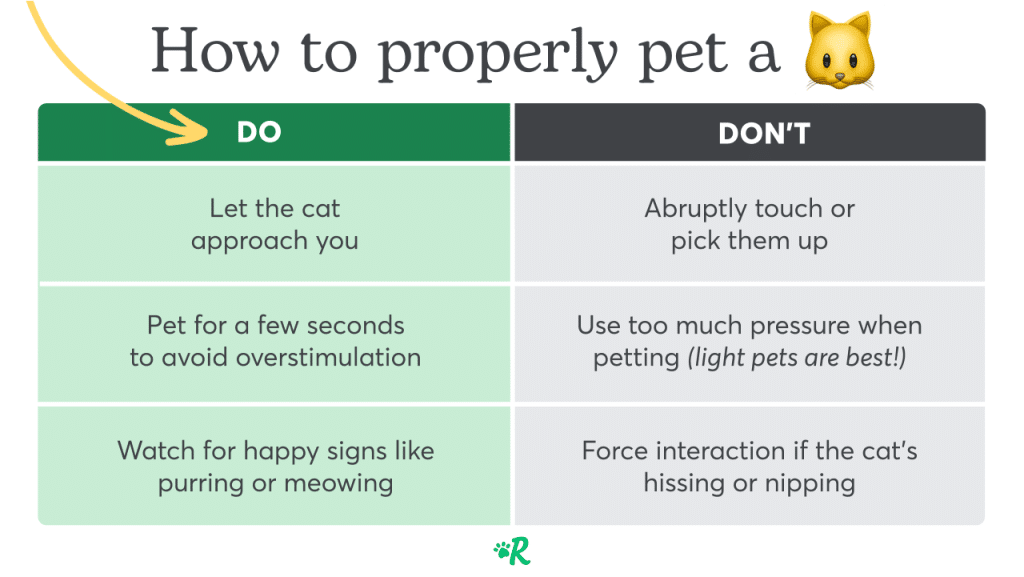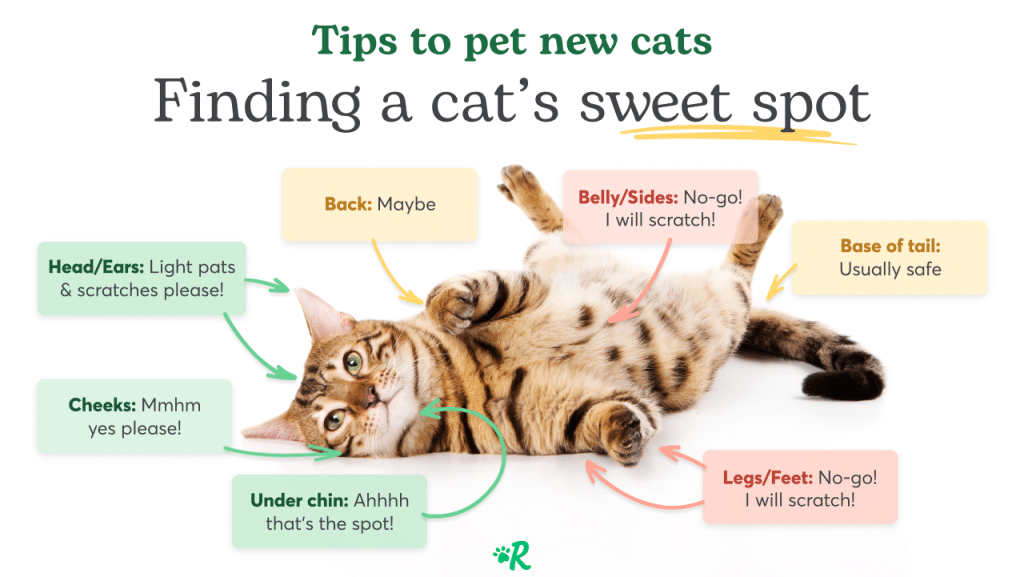- This article has been reviewed by a pet health professional. It is not a substitute for professional veterinary advice.
It can be tempting to want to run your fingers through the majestic floof of a long-haired cat or tickle your kitty’s tummy when they sprawl out in a pool of sunshine. But before you let your fingers take the lead, consider your cat’s preferences.
For some kitties, petting is better than catnip. Other cats might contemplate murder if you raise a finger in their direction. We spoke to feline behaviorists to understand how to pet them and ways to tell when they’ve had enough.
How to Pet a Cat
Pet a cat in the direction your cat’s fur grows, using short and gentle strokes. Brushing them backward in brisk, rough motions from their tail up to their head or using long, heavy strokes can be overstimulating for cats.
“Generally, soft petting is best, but some cats might appreciate harder petting, more like massaging,” adds feline behaviorist Stephen Quandt, CFTBS and founder of Feline Behavior Associates.
When petting cats and kittens, avoid:
- Abruptly grabbing them
- Snatching them up
- Forcibly restraining a kitten
- Using too much pressure
There is no right answer on when to stop, however. How much petting cats want often depends on their personality and mood.
Some senior couch potatoes are content to cuddle with their favorite human with gentle petting for hours. On the other paw, some very high-energy or perpetually playful cats would rather stalk, chase, and hunt their favorite toys than receive pets.

Infographic by Rover
Do cats enjoy massages?
“Massaging down their backbone and a gentle open-handed pat at the tail base will sometimes result in a purr,” says Dr. Cruz.
To find out how much pressure to use, apply different amounts of pressure while carefully reading their body language. “If the cat is leaning into you, it’s probably safe to increase the pressure,” adds Cassiday. “If they’re neutral or leaning away, it could be a sign to step back.”
Where Do Cats Like to Be Pet?
While all cats are individuals with different preferences, the most cat-friendly petting spots typically include:
- Top and back of the head
- Cheeks
- Under chin
- Back of neck
- On, between, and behind ears
- Base of tail
“It’s always safest to stick to the head and cheeks. When cats are friends with each other, they will often groom each other there as a sign of affection,” says Laura Cassiday, Certified Cat Behavior Consultant and founder of Pawsitive Vibes Cat Behavior & Training. “Petting your cat’s head is most similar to what a member of his own species would do.”

Infographic by Rover
Off-limit Zones for Petting
Conversely, some spots on a cat’s body are universally disliked. Generally off-limit, no-touch petting zones include:
- Tummy
- Tail
- Paws or toes
- Lower back
- Legs
It’s tempting to want to tickle a cat’s irresistible toe beans and their fuzzy bellies, but these are two of the most sensitive areas on a cat’s body. “Most cats hate having their stomachs or paws manipulated,” adds Dr. Bernadine Cruz, DVM, emeritus veterinarian associated with Laguna Hills Animal Hospital. Forcibly belly rubbing or grabbing your cat’s paws can stress them out and result in you getting bunny-kicked, scratched, or bitten.
When To Stop Petting
Petting can quickly become one-sided, so it’s best to stop petting cats when they decide they’ve had enough. “Many cats will turn that part of their body that you’re petting away from you. Some may also leave the area,” Quandt says.
Sometimes, a cat will take a less passive approach to show they’re done with petting. “If your cat tenses and strikes out, they may have had enough,” Dr. Cruz says. “Stop and don’t reprimand your cat. They have the right to personal space just as we do. No means no.”
Other signs your cat makes to say they’re done with pets:
- Ears pulled back
- Dilated pupils
- Tail quickly swishing back and forth or thumping
- Growling or hissing
- Swatting
- Lunging or charging
If your cat is suddenly rejecting pets, consider seeing a vet. A change in preferences and behavior could indicate an underlying health condition. “You may have inadvertently touch a spot that causes pain or discomfort, such as arthritis,” Dr. Cruz explains.
Does Your Cat Want to Be Pet?
Unlike some of the more puzzling and confusing cat behaviors, knowing when a cat wants to be petted is pretty unmistakable. That’s true even if you’re a newbie when it comes to understanding cat body language. “Cats will often offer the part of their bodies that they most want petted, like their cheeks,” adds Quandt.
Some kitties might demand physical affection in the following ways:
- Rubbing up against you
- Headbutting you
- Purring
- Meowing
- Making eye contact like a slow blink with relaxed, half-closed eyes
If the kitty you want to pet isn’t directly seeking attention from you, Cassiday recommends using a consent test to provide choice and agency and, ultimately, build trust.

Infographic by Rover
How to use a consent test with a cat:
- Hold your hand out to the cat.
- Let the cat approach you.
- Move your hand a few inches from his or her head.
- Let the cat initiate the petting with their head or body.
- Pet for a few seconds, and then hold your hand slightly away again.
- Let the cat reinitiate the petting.
- Repeat until the cat walks away.
What To Do if Your Cat Hates Being Pet
If your cat hates being petted, that’s okay. There are many other ways you can show affection and have fun together without straining your relationship.
“Play is a great substitute,” Quandt offers. “Providing your cat with other forms of enrichment like climbing trees, tunnels, and puzzle feeders is always good.” Training your cat and taking them outside in a cat backpack, harness, or leash is a great way to safely expand their world, keep things exciting, and tighten your bond.
Or, if you really want to think outside the cardboard box, you can take on a whole new challenge. “I’m a big fan of clicker training,” Cassiday says. “It’s a lot of fun and a great bonding experience to teach your cat tricks.”



